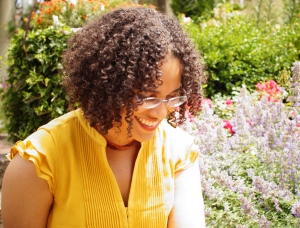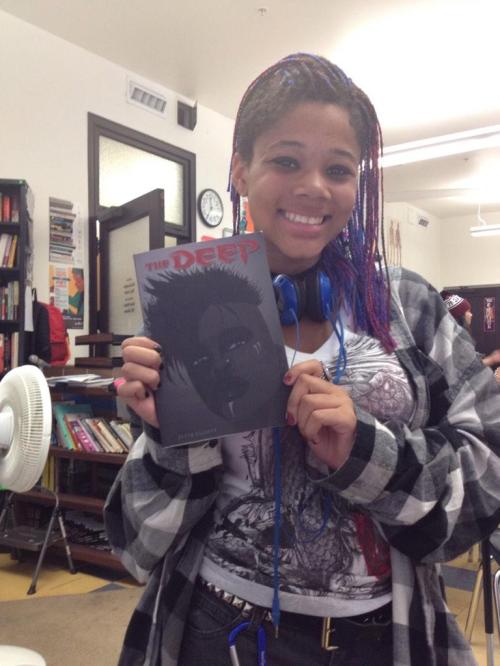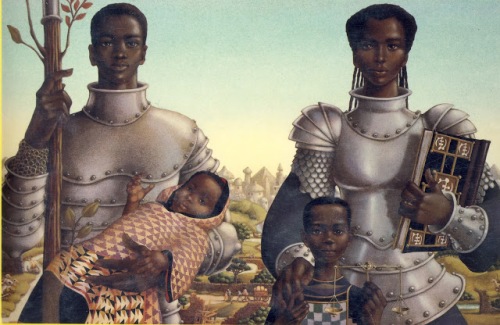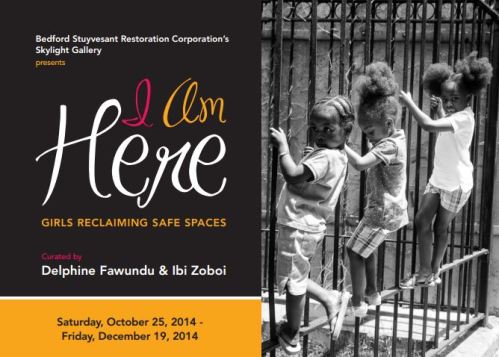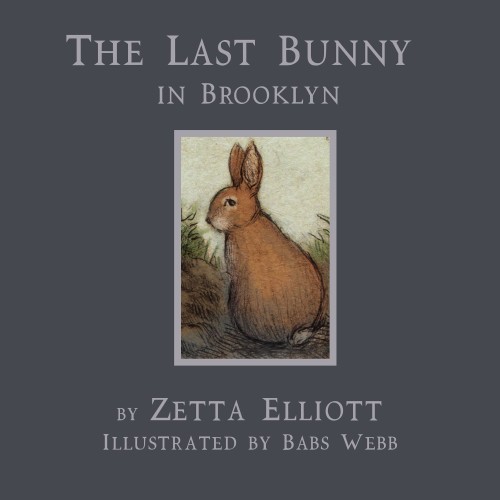My new website is up and running—and I love it! I will be blogging over there from now on, so I hope you’ll take a look. You can also find my essays, videos, and other important links over there. I will check with my web designer to see if current subscribers need to sign up again at the new site (I don’t think so). Just had the most amazing afternoon at the Brooklyn Museum Children’s Book Fair…sold almost all my books and had people coming back for titles that had sold out. Some people even asked to see An Angel for Mariqua, which I was editing whenever I had a spare moment. The demand is real! I know it, I say it all the time, but there’s nothing like seeing parents and kids excited about the books I create! I’ll have 2 more titles ready for December so stay tuned. You can read my blog, “like” my Author Zetta Elliott page on Facebook, and/or follow me on Twitter (@zettaelliott). The new website gives you the option of signing up for my newsletter, too. See you over there!
![Pageflex Persona [document: PRS0000038_00051]](https://zettaelliott.files.wordpress.com/2009/07/download-phoenix-cover-aug-1-front.jpg?w=200&h=300) I’ll be speaking on an Afrofuturism panel at Brooklyn College next week, and I hope I’ll have the chance to talk about After Earth. Most critics panned the film but for Black youth (boys in particular), that film is groundbreaking—something white reviewers just don’t get. Sometimes I think it’s not worthwhile to send my books out for review because many reviewers fail to situate the book within Black storytelling traditions and within the context of the publishing industry (what’s already available—or not). So I’m especially grateful to Charlotte over at Charlotte’s Library for her thoughtful review of The Phoenix on Barkley Street and her provocative, appropriate introduction:
I’ll be speaking on an Afrofuturism panel at Brooklyn College next week, and I hope I’ll have the chance to talk about After Earth. Most critics panned the film but for Black youth (boys in particular), that film is groundbreaking—something white reviewers just don’t get. Sometimes I think it’s not worthwhile to send my books out for review because many reviewers fail to situate the book within Black storytelling traditions and within the context of the publishing industry (what’s already available—or not). So I’m especially grateful to Charlotte over at Charlotte’s Library for her thoughtful review of The Phoenix on Barkley Street and her provocative, appropriate introduction:
Quick–think of a fantasy book written for early elementary aged kids of 8 or so, where the fantasy stars a group of minority kids and takes place in an urban neighborhood where gangs and abandoned properties are big problems, just like they are in many place[s] in real life, and where the fantasy part itself is something truly beautiful and magical and hopeful….
I can think of one, because I just read it– The Phoenix on Barkley Street, by Zetta Elliott (self published, August 2014, ages 7-9), and tomorrow I will take it to a Little Free Library that is in just such a neighborhood, and hope that it falls into the hands of young readers who haven’t yet been told that magic can happen to kids just like them.
So glad the book will find its way into kids’ hands! Charlotte concludes her review with a working list of first chapter books/young elementary school books that are fantasies with kids of color—and only 3 titles made the list, including another one of mine, The Magic Mirror. Does that mean a reviewer has to declare my book a masterpiece? No. But I think it’s important to see this book not just as a story, but an intervention:
So it’s a good story, and the writing is just right for a third or fourth grade reader getting their reading legs under them, as it were, and yay! for diversity and urban fantasy targeted at this age group. And yay! for kids of color in fantasy books for elementary school readers–I think it’s awfully important to have lots of these, so that ever[y] kid can be given a place at the table of the imagination, and there really aren’t many at all. Once you know that you can be in a fantasy story, you can allow yourself to dream whatever you want…..
I’m making progress on The Return and am thoroughly enjoying reviewing the chapters I wrote while I was in Dakar last July. I think Book 3 in the “freaks & geeks” trilogy will be shorter than Book 2, but fast-paced. Today I’m hoping to write the chapter that features a djeli (historian/storyteller) who looks a lot like Lupita Nyong’o…
Posted in Uncategorized | 1 Comment »
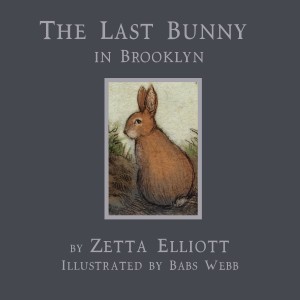 Children’s literature is not neutral. It can be educational and entertaining, but books for kids also tell us something about our society and ourselves. As I wrote in my last HuffPo essay,
Children’s literature is not neutral. It can be educational and entertaining, but books for kids also tell us something about our society and ourselves. As I wrote in my last HuffPo essay,
There’s clearly a direct link between the misrepresentation of Black youth as inherently criminal and the justification given by those who brazenly take their lives. The publishing industry can’t solve this problem, but the relative lack of children’s books by and about people of color nonetheless functions as a kind of “symbolic annihilation.” Despite the fact that the majority of school-age children in the US are now kids of color, the US publishing industry continues to produce books that overwhelmingly feature white children only. The message is clear: the lives of kids of color don’t matter.
I’m not a citizen so I can’t vote—and that stings a bit when I look at yesterday’s election results. But even if I can’t vote, I can still remain politically engaged as a writer and educator—and self-publisher. The Last Bunny in Brooklyn, my allegory about race and social dislocation, is available online now (you should be able to order it from bookstores within a week). And I’m excited to be working with this talented illustrator once more; Babs is making amazing progress on Fox & Crow: a Christmas Tale, and I hope to publish that illustrated book along with my middle grade novel, An Angel for Mariqua, next month. Mariqua’s mom is incarcerated—Black women’s rising rates of incarceration mattered to me back in 2000 when I wrote this novel, and it still matters today. Be sure to check out the Crunk Feminist Collective’s new series: Voices from Inside, which lets women in prison tell their story, their way…
Posted in Uncategorized | 4 Comments »
 I used to tell people that I lived under a rock. I’m an HSP and one way I manage my various sensitivities is by withdrawing from the world; my home is my sanctuary and I try to keep it clutter-free by conducting regular purges so that I only keep the things I truly need and use. Last year I briefly considered downsizing and moving into a studio apartment. There’s something appealing about letting go of one’s possessions; as much as I love the antiques I inherited from my grandparents, holding onto them limits my ability to move. When I visited The Cloisters last weekend, I thought about the monastic life and how lovely it would be to live in silence in a small, bare cell. I took the garden tour but would have enjoyed it much more without the many tourists that fill The Cloisters on the weekend. On Saturday I took the train to Philly and made sure I got a seat in the quiet car. Right now my building is blissfully silent—no barking dogs in neighboring apartments, no hammering by construction workers up on the roof. I need to go for a run but I hate to lose this moment! I value solitude, silence, and simplicity but even I know that too much of those things can destroy a human being. In the 1800s, however, prison reformers thought criminals could be reformed if given time alone to reflect on their actions. Eastern Sate Penitentiary was designed—at great expense—to house prisoners in solitary confinement with walls so thick that communication was impossible. Guards wore socks over their shoes to muffle the sound of their footsteps, and prisoners were led to their cells wearing hoods so that they had no sense of the prison’s layout. They
I used to tell people that I lived under a rock. I’m an HSP and one way I manage my various sensitivities is by withdrawing from the world; my home is my sanctuary and I try to keep it clutter-free by conducting regular purges so that I only keep the things I truly need and use. Last year I briefly considered downsizing and moving into a studio apartment. There’s something appealing about letting go of one’s possessions; as much as I love the antiques I inherited from my grandparents, holding onto them limits my ability to move. When I visited The Cloisters last weekend, I thought about the monastic life and how lovely it would be to live in silence in a small, bare cell. I took the garden tour but would have enjoyed it much more without the many tourists that fill The Cloisters on the weekend. On Saturday I took the train to Philly and made sure I got a seat in the quiet car. Right now my building is blissfully silent—no barking dogs in neighboring apartments, no hammering by construction workers up on the roof. I need to go for a run but I hate to lose this moment! I value solitude, silence, and simplicity but even I know that too much of those things can destroy a human being. In the 1800s, however, prison reformers thought criminals could be reformed if given time alone to reflect on their actions. Eastern Sate Penitentiary was designed—at great expense—to house prisoners in solitary confinement with walls so thick that communication was impossible. Guards wore socks over their shoes to muffle the sound of their footsteps, and prisoners were led to their cells wearing hoods so that they had no sense of the prison’s layout. They  could go outside for one hour a day, but only by stepping into an adjacent cell that was exposed to the sky. No grass. No human contact. No sound. A tiny cell with a bed, and a toilet, and a table where prisoners practiced a trade. The writer in me finds this both appealing and appalling. I could probably live like that for 2 days but after that, I’d start to lose it. Solitude diminishes in value without the contrast of human interaction. To be endlessly alone is torture, which is why we need to end solitary confinement in prisons if our goal really is rehabilitation. How can anyone heal without community—beauty—nature—touch? Cherish your freedom because 2 million people in this country have none.
could go outside for one hour a day, but only by stepping into an adjacent cell that was exposed to the sky. No grass. No human contact. No sound. A tiny cell with a bed, and a toilet, and a table where prisoners practiced a trade. The writer in me finds this both appealing and appalling. I could probably live like that for 2 days but after that, I’d start to lose it. Solitude diminishes in value without the contrast of human interaction. To be endlessly alone is torture, which is why we need to end solitary confinement in prisons if our goal really is rehabilitation. How can anyone heal without community—beauty—nature—touch? Cherish your freedom because 2 million people in this country have none.
Posted in Uncategorized | Leave a Comment »
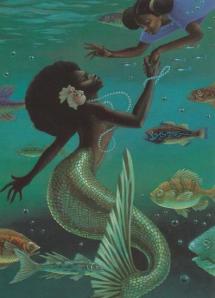 I always take a selfie on my birthday but this year I’ve been taking pictures all month long. Every time I’m out with friends, I ask someone to snap a photo with their phone so that there’s proof of our outing. I’ve just started writing again—850 words yesterday, 300 the day before. I’m hoping to get back up to a thousand words a day, which should allow me to finish The Return by Xmas. I have my first BPL-sponsored school visit in a few days and since I’m no longer teaching, I have plenty of days when I don’t have to leave the house. Which is good when I’m writing, but not so good when I’m not. Yesterday I went up to the Society of Illustrators to see The Original Art show and the Leo & Diane Dillon retrospective. The Original Art exhibit took up two floors and the artwork was just stunning. I was counting, of course—how many of these illustrators are people of color? How many are women of color? How many artists had multiple submissions? I barely noticed who won the gold and silver medals, perhaps because I was thinking about this article: “If you’re lucky enough to earn a living from your art, you’re probably white.” Which isn’t surprising but is nonetheless frustrating, and I found myself wondering as I wandered through the exhibit, “Who’s never had a chance to shine?” It’s an honor to be included in the show, but if you aren’t being asked to illustrate picture books, then there’s no chance your art will be deemed “good enough.” The outing soured further when I went up to the third floor and discovered that the Dillon exhibit was IN THE RESTAURANT. So it was hard to get close to the art since there were diners, and waiters, and
I always take a selfie on my birthday but this year I’ve been taking pictures all month long. Every time I’m out with friends, I ask someone to snap a photo with their phone so that there’s proof of our outing. I’ve just started writing again—850 words yesterday, 300 the day before. I’m hoping to get back up to a thousand words a day, which should allow me to finish The Return by Xmas. I have my first BPL-sponsored school visit in a few days and since I’m no longer teaching, I have plenty of days when I don’t have to leave the house. Which is good when I’m writing, but not so good when I’m not. Yesterday I went up to the Society of Illustrators to see The Original Art show and the Leo & Diane Dillon retrospective. The Original Art exhibit took up two floors and the artwork was just stunning. I was counting, of course—how many of these illustrators are people of color? How many are women of color? How many artists had multiple submissions? I barely noticed who won the gold and silver medals, perhaps because I was thinking about this article: “If you’re lucky enough to earn a living from your art, you’re probably white.” Which isn’t surprising but is nonetheless frustrating, and I found myself wondering as I wandered through the exhibit, “Who’s never had a chance to shine?” It’s an honor to be included in the show, but if you aren’t being asked to illustrate picture books, then there’s no chance your art will be deemed “good enough.” The outing soured further when I went up to the third floor and discovered that the Dillon exhibit was IN THE RESTAURANT. So it was hard to get close to the art since there were diners, and waiters, and ![Pageflex Persona [document: PRS0000419_00052]](https://zettaelliott.files.wordpress.com/2009/07/bookcover7x10_cream_50rev-july-28-front.jpg?w=209&h=300) tables, and steaming pans of food in the way. I guess I could have asked to speak to the curator, but instead I left thinking to myself, “Of course. Of course the art I really want to see is treated that way.” I can remember visiting Black-owned A&B Books when I first came to NYC and marveling at all the book covers that featured art by the Dillons. I’d never seen Black folks depicted so beautifully—and magically. I may print out a bunch of Dillon illustrations from the web and pin them to my bulletin board to inspire me as I write. Their art is the stuff of dreams…
tables, and steaming pans of food in the way. I guess I could have asked to speak to the curator, but instead I left thinking to myself, “Of course. Of course the art I really want to see is treated that way.” I can remember visiting Black-owned A&B Books when I first came to NYC and marveling at all the book covers that featured art by the Dillons. I’d never seen Black folks depicted so beautifully—and magically. I may print out a bunch of Dillon illustrations from the web and pin them to my bulletin board to inspire me as I write. Their art is the stuff of dreams…
My birthday is tomorrow but this email I received on Thursday is the best possible gift:
Ms. Elliott,
My daughter recently received The Magic Mirror for a gift a few weeks ago and it’s amazing. All I kept saying was ‘I have to find this author and say thank you, I have to.’ This has become my daughter’s favorite book and she takes it everywhere with us. Thank you for writing and publishing a book like that and all the others that you have, it means a lot to us.
I have to believe that even when we’re marginalized, our work will find a way to those who need it most. I’ve decided to draft an open letter to the We Need Diverse Books committee. They’re doing important work but lasting change won’t happen unless they address the source of the problem. I’m glad that Brown Girl Collective posted this quote from Audre Lorde on Facebook yesterday:
When we speak we are afraid our words will not be heard or welcomed. But when we are silent, we are still afraid. So it is better to speak.
~ Audre Lorde (1934-1992), poet, author and activist
Posted in Uncategorized | 7 Comments »
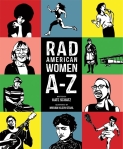 While I was in Sacramento I met Kate Schatz, Chair of the School of Literary Arts at Oakland School for the Arts and author of Rad American Women A-Z. Laura Atkins introduced us (of course) and persuaded Kate to take a look at my books (of course). Today I woke up and found this awesome photo on Twitter; Kate wrote, “This is my student Amaya, who looooooooooved The Deep! I knew she’d dig it.” With her awesome sense of style, Amaya could BE Nyla, and I hope the novel served as a “mirror” for her. Yesterday I said I was going to work on Judah’s Tale next but now I feel like Nyla’s got something more pressing to say…
While I was in Sacramento I met Kate Schatz, Chair of the School of Literary Arts at Oakland School for the Arts and author of Rad American Women A-Z. Laura Atkins introduced us (of course) and persuaded Kate to take a look at my books (of course). Today I woke up and found this awesome photo on Twitter; Kate wrote, “This is my student Amaya, who looooooooooved The Deep! I knew she’d dig it.” With her awesome sense of style, Amaya could BE Nyla, and I hope the novel served as a “mirror” for her. Yesterday I said I was going to work on Judah’s Tale next but now I feel like Nyla’s got something more pressing to say…
This morning I also found out that I will *not* be getting fully reimbursed for my Senegal trip back in July. And you know what? As annoying as that is, it’s ok. Because the research I conducted on that trip will enable me to write the final (?) book in the “freaks & geeks” trilogy. And if Amaya’s the only Black girl who reads The Return, that will be ok, too. As Nyla learns in Book 3, sometimes being radical means being on your own…
Posted in Uncategorized | 2 Comments »
I’ve started planning my annual low-key birthday celebration. This Brooklyn photography exhibit is on the list along with the Dillons’ retrospective at the Society of Illustrators. Then on the actual day I think I’ll visit the Cloisters and maybe have Ethiopian food with friends. The best gift would be to start writing again…tired of editing and the endless administrative tasks that go into publishing a book. I’m prepping An Angel for Mariqua and Fox & Crow: a Christmas Tale for a Thanksgiving release; if I can then start working on Judah’s Tale, I’ll publish that YA novel and Billie’s Blues (a picture book) in early 2015. Happy Birthday…get busy!
Posted in Uncategorized | 1 Comment »
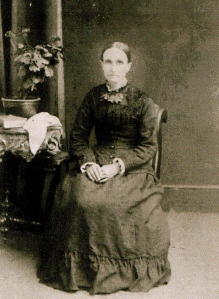 My website’s getting an overdue overhaul and it’s been challenging to find a “look” that represents who I am as a writer. There will be purple, of course, but I originally wanted a “plantation ruins” aesthetic that proved hard to achieve. My designer asked for a quote for the site and I was initially stumped but finally went with a line uttered by Genna in A Wish After Midnight: “I don’t know which matters more—where the seed comes from, or where it takes root and grows.” I realized that I wanted my ancestor photos to appear on the site because they are my source—folks from Canada, Nevis, and the US. I just tidied up the ancestor wall in my apartment and framed a “new” photo that my uncle gave me a couple of years ago; Ellen Gowland (above) married my great-great-grandfather James Henry Allen, and one of her sisters married one of his brothers. Ellen’s white family was so appalled at her marriage to a Black man that they moved and changed their surname (to Golden, I think). Unreal. James wouldn’t allow himself to be photographed because he didn’t want his descendants to be
My website’s getting an overdue overhaul and it’s been challenging to find a “look” that represents who I am as a writer. There will be purple, of course, but I originally wanted a “plantation ruins” aesthetic that proved hard to achieve. My designer asked for a quote for the site and I was initially stumped but finally went with a line uttered by Genna in A Wish After Midnight: “I don’t know which matters more—where the seed comes from, or where it takes root and grows.” I realized that I wanted my ancestor photos to appear on the site because they are my source—folks from Canada, Nevis, and the US. I just tidied up the ancestor wall in my apartment and framed a “new” photo that my uncle gave me a couple of years ago; Ellen Gowland (above) married my great-great-grandfather James Henry Allen, and one of her sisters married one of his brothers. Ellen’s white family was so appalled at her marriage to a Black man that they moved and changed their surname (to Golden, I think). Unreal. James wouldn’t allow himself to be photographed because he didn’t want his descendants to be 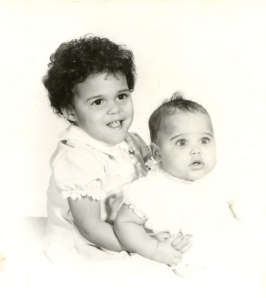 ashamed…what I wouldn’t give to see his face! That tells you just how racist Canada was (is); it was so hard being Black that he decided the family would gradually leave their blackness behind and “pass” for white. Some of James’ and Ellen’s kids could pass for white but some could not; my great-grandfather Richard Allen fell into the latter category. I don’t know if he’d be proud of me—I don’t know if he hated blackness or just the way Blacks were disadvantaged throughout Canadian society. I wish I had more photographs of my Caribbean family. My mother took me and my sister to a professional portrait studio when I was about 6 months old; apparently I was sensitive to bright light even back then because the photographer’s flash left me wide-eyed for hours…
ashamed…what I wouldn’t give to see his face! That tells you just how racist Canada was (is); it was so hard being Black that he decided the family would gradually leave their blackness behind and “pass” for white. Some of James’ and Ellen’s kids could pass for white but some could not; my great-grandfather Richard Allen fell into the latter category. I don’t know if he’d be proud of me—I don’t know if he hated blackness or just the way Blacks were disadvantaged throughout Canadian society. I wish I had more photographs of my Caribbean family. My mother took me and my sister to a professional portrait studio when I was about 6 months old; apparently I was sensitive to bright light even back then because the photographer’s flash left me wide-eyed for hours…
In other news, here’s the cover for my latest book:
Posted in Uncategorized | Leave a Comment »
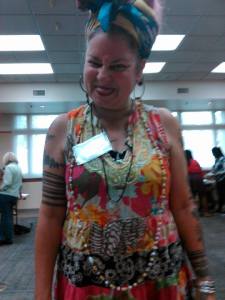 I’m not sure when I stopped caring whether people thought of me as “nice.” I’ve known for a long time that I’m not “sweet,” and I know some people find me intimidating because I’ve learned from so many Black feminists before me that “your silence will not protect you.” Yesterday morning I got back from Sacramento and despite jet lag went out in the evening to celebrate a friend’s 40th birthday. On the train ride home we were acting very silly and laughing hard and loud. I asked her why she doesn’t want to call herself middle-aged as I proudly do, and she replied that unlike me, she hadn’t always been invested in seeming older. I skipped a grade when I was 6 so I did spend much of my early academic life thinking a lot about my age; I knew I could compete academically, but I was afraid of doing socially inappropriate things that might lead people to realize I was younger than my peers. In college age only mattered because I stayed underage longer than my friends, but since I didn’t drink anyway, it wasn’t such a big deal. Somewhere in my thirties I started wishing I looked older; almost all of my friends have very visible grey hair and I’ve got just two white strands that can hardly be seen amidst my copious curls. I don’t like being underestimated and I think if I looked my age, perhaps people would stop referring to me as “a young woman,” which is what people call me right before they dismiss me or express amazement over my abilities. I should be articulate. I should be forthright. I should call out b.s. when I see it. I should speak up when something appears unjust. Why do people expect anything less?
I’m not sure when I stopped caring whether people thought of me as “nice.” I’ve known for a long time that I’m not “sweet,” and I know some people find me intimidating because I’ve learned from so many Black feminists before me that “your silence will not protect you.” Yesterday morning I got back from Sacramento and despite jet lag went out in the evening to celebrate a friend’s 40th birthday. On the train ride home we were acting very silly and laughing hard and loud. I asked her why she doesn’t want to call herself middle-aged as I proudly do, and she replied that unlike me, she hadn’t always been invested in seeming older. I skipped a grade when I was 6 so I did spend much of my early academic life thinking a lot about my age; I knew I could compete academically, but I was afraid of doing socially inappropriate things that might lead people to realize I was younger than my peers. In college age only mattered because I stayed underage longer than my friends, but since I didn’t drink anyway, it wasn’t such a big deal. Somewhere in my thirties I started wishing I looked older; almost all of my friends have very visible grey hair and I’ve got just two white strands that can hardly be seen amidst my copious curls. I don’t like being underestimated and I think if I looked my age, perhaps people would stop referring to me as “a young woman,” which is what people call me right before they dismiss me or express amazement over my abilities. I should be articulate. I should be forthright. I should call out b.s. when I see it. I should speak up when something appears unjust. Why do people expect anything less?
I haven’t read any of Malcolm Gladwell’s books, but I read an interview with him recently where he summed up his latest theory about people who are disruptive in the best possible way. This is the gist of his theory: 1) be completely indifferent to what people say about you (disruptors “are what psychologists call disagreeable—they do not require the approval of their peers in order to do what they think is correct.” 2) develop an active imagination—reimagine the world by reframing the problem in a way no one has framed it before. 3) reframe the problem to remove constraints so that you can act with urgency.
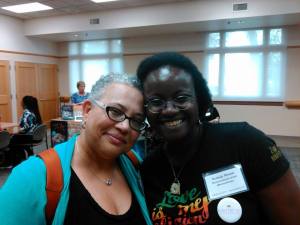 It can be challenging when you’re surrounded by people who don’t share your sense of urgency. Day 1 of Kidlitcon was fabulous because right from the start I found attendees who seemed like potential disruptors. After years of chatting online, I finally got to meet Multiculturalism Rocks! blogger Nathalie Mvondo (on right with librarian/blogger Edith Campbell) and her opening panel was fantastic. Unlike traditional conferences, Kidlitcon had a very open format—presenters often started by asking for audience input and the code of conduct probably wasn’t necessary because almost all the attendees were women, which means conversations were conducted with courtesy and consideration. By Day 2, I noticed more attendees expressing a desire not to be “too negative,” which is unfortunate because sometimes rigor demands that we abandon the (socialized) urge to be pleasant and positive all the time. After the We Need Diverse Books panel, my friend and fellow publishing industry disruptor Laura Atkins and I had to take a walk around the block to blow off some steam. The night before
It can be challenging when you’re surrounded by people who don’t share your sense of urgency. Day 1 of Kidlitcon was fabulous because right from the start I found attendees who seemed like potential disruptors. After years of chatting online, I finally got to meet Multiculturalism Rocks! blogger Nathalie Mvondo (on right with librarian/blogger Edith Campbell) and her opening panel was fantastic. Unlike traditional conferences, Kidlitcon had a very open format—presenters often started by asking for audience input and the code of conduct probably wasn’t necessary because almost all the attendees were women, which means conversations were conducted with courtesy and consideration. By Day 2, I noticed more attendees expressing a desire not to be “too negative,” which is unfortunate because sometimes rigor demands that we abandon the (socialized) urge to be pleasant and positive all the time. After the We Need Diverse Books panel, my friend and fellow publishing industry disruptor Laura Atkins and I had to take a walk around the block to blow off some steam. The night before 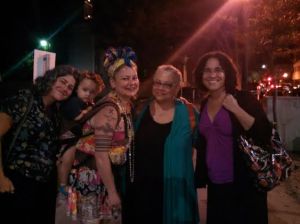 we’d had dinner with Edi, Maya Gonzalez, and her beautiful family; we scarfed down tasty vegetarian food and lingered over apple spice cake drizzled with cider syrup…it felt very indulgent and yet also very necessary. So few people truly embrace change and aren’t afraid to be disruptive. I forget that sometimes because I’ve been a “troublemaker” within my family for decades and most of my friends are outspoken feminists of color. We tend not to wait. We don’t “go slow.” We try to build the reality we see in our dreams. Of course, everyone has to follow her own path and I left Sacramento reminding myself that what’s urgent to me won’t ever be urgent to everyone else. But we did meet new allies and I’m especially encouraged by the 20-somethings at Kidlitcon who seem poised to turn their anger into action. Watch out for the Twinjas’ Diverse Blog Tour and brace yourself for the unfiltered reflections of Sarah Hannah Gómez. And don’t count out we middle-aged mamas who are still plotting revolution offline…
we’d had dinner with Edi, Maya Gonzalez, and her beautiful family; we scarfed down tasty vegetarian food and lingered over apple spice cake drizzled with cider syrup…it felt very indulgent and yet also very necessary. So few people truly embrace change and aren’t afraid to be disruptive. I forget that sometimes because I’ve been a “troublemaker” within my family for decades and most of my friends are outspoken feminists of color. We tend not to wait. We don’t “go slow.” We try to build the reality we see in our dreams. Of course, everyone has to follow her own path and I left Sacramento reminding myself that what’s urgent to me won’t ever be urgent to everyone else. But we did meet new allies and I’m especially encouraged by the 20-somethings at Kidlitcon who seem poised to turn their anger into action. Watch out for the Twinjas’ Diverse Blog Tour and brace yourself for the unfiltered reflections of Sarah Hannah Gómez. And don’t count out we middle-aged mamas who are still plotting revolution offline…
Posted in Uncategorized | 18 Comments »
Kidlitcon is just a few days away and I’m working on my panel presentation, which means I’m gathering up all the bits and 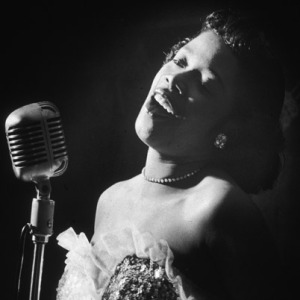 pieces that explain why I do what I do. I’m a bit of a mess these days. On Sunday the protestors singing a “Requiem for Mike Brown” brought me to tears; the night before I pulled out my Sarah Vaughan CD and got misty while writing about my father in the introduction to an article I later scrapped. Late last week there was quite a dust up over at the Horn Book blog when Roger Sutton decided to explain why there’s no place for self-published books in his elite review journal. He subsequently offered a “Selfie Sweepstakes,” which I won’t be entering, but the debate at least made me clarify my point of view and connected me with some sympathetic folks online. And yesterday I heard from Amy Martin at the Oakland Public Library; last spring she and other librarians explained the importance of shelving books, which prompted me to resize three of my recently published titles. As Amy explains on the OPL blog, Max Loves Muñecas! now meets their formatting standards and will hopefully be on the shelves soon…
pieces that explain why I do what I do. I’m a bit of a mess these days. On Sunday the protestors singing a “Requiem for Mike Brown” brought me to tears; the night before I pulled out my Sarah Vaughan CD and got misty while writing about my father in the introduction to an article I later scrapped. Late last week there was quite a dust up over at the Horn Book blog when Roger Sutton decided to explain why there’s no place for self-published books in his elite review journal. He subsequently offered a “Selfie Sweepstakes,” which I won’t be entering, but the debate at least made me clarify my point of view and connected me with some sympathetic folks online. And yesterday I heard from Amy Martin at the Oakland Public Library; last spring she and other librarians explained the importance of shelving books, which prompted me to resize three of my recently published titles. As Amy explains on the OPL blog, Max Loves Muñecas! now meets their formatting standards and will hopefully be on the shelves soon…
I just read an article about a study that shows whites are becoming less supportive of diversity initiatives as people of color shift from minority to majority status in the US. This piece will definitely become part of my Kidlitcon talk:
The researchers say the results are related to whites feeling threatened in a way that is distinct from their concerns about economic competition or clashing cultural values. They concluded that the demographic changes are threatening whites’ sense that they best represent the American identity.
“Whites have long benefited from being seen as the ethnic group that best represents what it means to be American,” said Huo, a faculty member in the UCLA College. “Thinking about a future in which whites are no longer a numerical majority threatens this claim to the American identity and, we have found, results in a reluctance to embrace diversity and greater support for newcomers to assimilate to American society.”
The “threat to identity,” Danbold said, is often overlooked in discussions about why whites are uneasy about changing demographics.
Posted in Uncategorized | 2 Comments »
